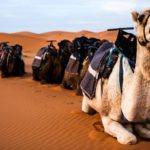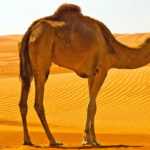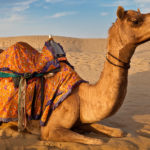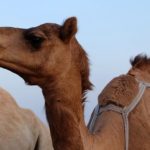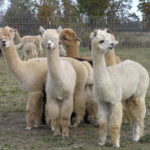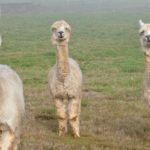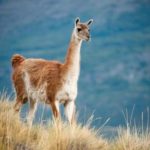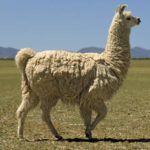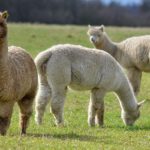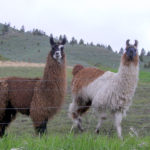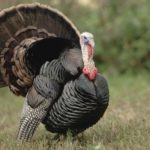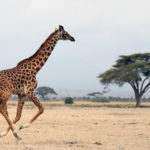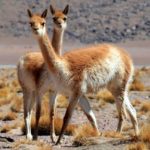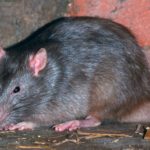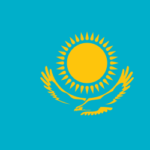Camels
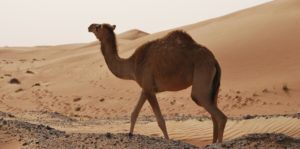 Camels with a physique look like hoofed animals, which is why they are often mistaken for cloven-hoofed animals. But in the structure of camels there are so many peculiar traits that they are singled out as a special detachment of the Muzolenogues. And it is quite reasonable, because they just do not have hoofs. Thus, the only relatives of camels are guanaco and vicuña. In the world, two kinds of camels are known – the two-humped (bactrian) and one-horned (dromedary), and the latter species are known only to domesticated individuals, so in the wild it is considered extinct.
Camels with a physique look like hoofed animals, which is why they are often mistaken for cloven-hoofed animals. But in the structure of camels there are so many peculiar traits that they are singled out as a special detachment of the Muzolenogues. And it is quite reasonable, because they just do not have hoofs. Thus, the only relatives of camels are guanaco and vicuña. In the world, two kinds of camels are known – the two-humped (bactrian) and one-horned (dromedary), and the latter species are known only to domesticated individuals, so in the wild it is considered extinct.
Camels are large animals, in height both species reach 2.5-3.6 m, a single-horned camel weighs 300-700 kg, a double-humped camel weighs 500-800 kg. The main external difference of camels is the humps of adipose tissue on the back. But they also have other features: the cervical arch of them bends down, and when walking, camels do not rest on the end of the toe (hoof), but on the last few phalanges of the fingers that form the calloused pillow. At the end of this pillow is visible a small claw that does not perform any supporting function. In total, the camel has two supporting fingers, so their pillows-feet are bifurcated and resemble the finiteness of artiodactyls. With the latter, they bring together the structure of the digestive system, the camels have a complex multi-chamber stomach, which allows them to digest the most coarse food as efficiently as possible.
Fighting cold and heat at the same time is not easy, so camels have one more unique device – wide limits of permissible body temperature. If in all mammals the body temperature is constant and the deviation of even one degree includes the mechanism of thermoregulation (sweating), the camels painlessly tolerate a rise in body temperature to 40 °, and also a decrease to 35 °. The camels begin to sweat only when the body temperature rises above 40 °, which means they save valuable moisture on sweating. In addition, a drop in body temperature at night by a couple of degrees allows camels to “stock up on coolness” for the upcoming day.
When all the ways for loss of moisture are blocked, the problem arises of its accumulation. But for a camel, this is not a problem. These animals are able to drink for a short time a huge amount of water (130-150 liters in 10 minutes), storing it in the stomach. Nutrients are deposited in the form of fat reserves in the humps, which in the event of a shortage of food and water begin to be consumed. When splitting fat as a by-product, water is formed, but in the case of a camel, this product is not just an incidental one, but the main one. And although the splitting of fat is not the main reason for the “drought resistance” of these animals, but it certainly helps the camel to cost a record long without water.
The ability of camels to do without watering is phenomenal: a two-humped camel calmly tolerates 3-5 days of “abstinence” in heat, one-five days with high physical exertion and 10 at rest. The secret of such endurance in the properties of the blood of a camel. Their oval red blood cells keep water in the vascular bed much longer than the erythrocytes of other animals, and do not stick together even when the body loses 25% of the fluid! Other animals can lose only 15% of the body’s water reserves without a threat to life. Indirectly, the low mobility of these animals also contributes to the preservation of moisture, camels are sluggish and unperturbed, they lead a measured way of life, adhere to a constant routine of the day.
Wild camels live in deserts and semi-deserts, overgrown with solianks, thorn bushes and stunted trees (saxaul trees). They lead a sedentary life, but within their areas make long daily transitions. The very word “camel” in translation from the Old Slavonic means “much wandering”, “walking a lot”. Usually camels graze in the morning and in the evening, in the afternoon they try to lie on the slopes of the dunes, chewing gum, here in the open spaces they sleep at night. The usual rate of movement of these animals is a step at a speed of 10 km / h. They have a very sharp vision and a person they see for a kilometer, in case of danger, camels try to leave in advance, not allowing rapprochement with the enemy. If this is not possible, then they pass to the amble and run at a speed of up to 25-30 km / h, in extreme cases camels flee at an awkward gallop, but not for long.
Camels live in family groups of 5-10 individuals, in the old days of the herd of wild Bactrian, there were up to 30 animals. In the herd, the male leader plays the leading role, he leads several adult females and their offspring. Mature males can live alone. The herd is calm and unperturbed, camels, like saving energy, avoid friendly games and conflicts with each other. The voice of a camel is a hoarse roar.
These animals feed on desert vegetation, they are extremely unpretentious and eat everything that grows on the root – bitter and salted grass, dry and thorny branches. The lips of the camel are forked and very mobile, and these animals are chewed a little, this allows the camel to easily have thorny plants. No wonder the desert shrubs were called “camel thorns”.
